This excerpt is from SEO in the Age of Gemini by Marie Haynes ©2024 and is reproduced with permission from Marie Haynes Consulting Inc.
Much of the SEO advice you’ll see online today stems from the shared wisdom of the community that was learned around Search in the days before Google actively used AI.
Much of what many of us do as SEO and treat as standard practice is based on a search engine that was a list of heuristics – handwritten rules programmed by humans. So much has changed.
For example, let’s say you’re tasked with creating a new article for the website you’re working on.
You’ll probably start with keyword research, because we know that to appear relevant to a search engine, you need to write content that thoroughly covers a topic and uses keywords that are semantically related to your topic.
Much of the content we have on the web today comes from a process that looks like this:
- Do keyword research to see what your competitors have written.
- Create content that is similar, but maybe a little better, or more comprehensive than theirs.
- Do keyword searches to see what other people have covered but you haven’t included.
- Create content that covers those things as well.
- Also ask people to search for related questions so we can write content that looks even more relevant and comprehensive to search engines.
- Create more content to answer these questions even though Google already has content to answer them.
Nothing in that process is causing us to create content that is truly original, insightful, and much more useful than what exists on the internet.
However, this is what Google wants to reward!
An SEO agency will often spend many hours each month improving a site’s technical SEO, improving its internal linking structure or perhaps getting external links and mentions. These are all things that can help a website look better to a search engine.
They are not bad things to do and some of them have the potential to help a site improve. But again, these things are unlikely to make the content on a page essentially more useful to searcherswhich is, once again, what Google wants to reward.
I want to be clear here. I’m not saying technical SEO is dead.
There are benefits to be had in having a technically sound and fast site that search engines can easily navigate and understand, especially if you have a large site.
Schema can still work wonders when it comes to helping Google understand your business and its EEAT, especially a new one. There are some verticals where technical improvements will give you enough of an edge to improve your rankings to some extent.
There is one thing that makes content more useful.
Are you ready for this deep and profound secret?
Here it is…
The secret to having content that is likely to be considered more useful by Google than others is to have content that users are finding useful..
A mindset shift is needed for SEOs
For over a decade now, my primary source of income has come from advising businesses on how to improve their search presence.
I’ve analyzed every word Google has published that speaks to what they want to reward and produced pages and pages of checklists, training documents and tips.
I had a goal: Help people understand what Google Rewards is and help them be in that result.
Do you see the paradox hidden in that statement? The more I think about it, it’s laughable!
I didn’t realize the whole time I was preaching about creation People first contentas Google now calls it, most of what I was doing was much more straight-forward Satisfying Google rather than searchers.
Other SEOs are catching on to this mindset now too. What users do on our websites is extremely important. User actions dramatically shape Google rankings.
I’ve historically treated Google’s guidelines for creating useful content as a checklist of things we can look for improvement.
Do you have an author bio? Check. Good descriptive title? Check. Demonstration of experience? Gaining information? Another check.
My first book on creating useful content takes you through multiple checklists like this one. you can see improvement by working through these checklists.
In fact, I know this because I will usually have people contact me to tell me that they implemented changes based on the checklists and saw improvements.
But it turns out that what Google gave us wasn’t a list of criteria to analyze like a checklist!
Now I understand that what Google was telling us was: Our systems are built to reward the kinds of things people tend to find useful and trustworthy. And if you want to know what that is, here are some ideas.
It is not a checklist, but rather a list of the kinds of things searchers tend to like. The algorithm is built to reward what searchers like.
An author bio is not a ranking factor, but, in many verticals, demonstrating your authors’ experience is something users like.
Web KPIs, metrics used to measure load times, and the like used to be a score we would aim to get…but really, the reason we work to improve Web KPIs is because users tend to like pages that load quickly and don’t jump around.
It’s not like Google has a checklist or scorecard when it comes to the quality of any page. Google doesn’t I know exactly what your content is or if it is high quality.
As we discussed earlier, search is a complex AI-driven system trying to predict what searchers will find useful.
Here’s the full list of “ideas” that Google gives us to help us understand what searchers might find useful:
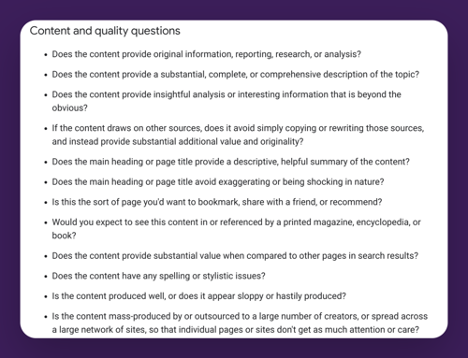
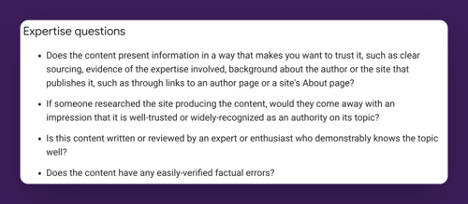

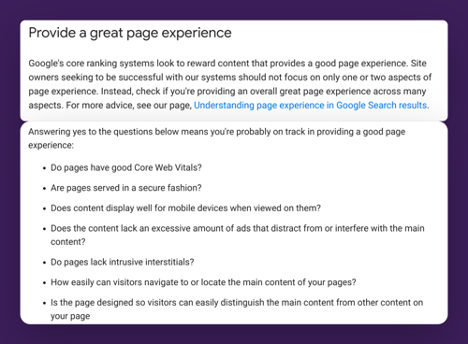
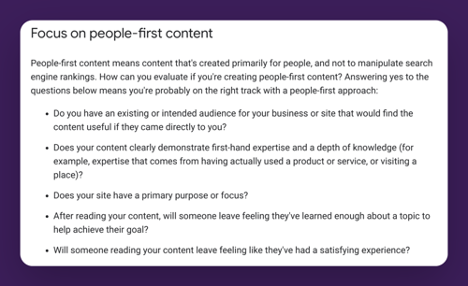
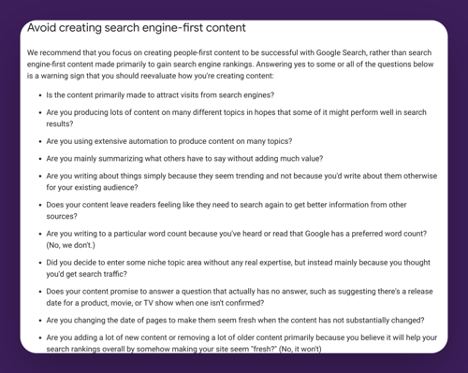
In the past I’ve learned to look at these ideals one at a time for inspiration on how you can improve your site. I still think there is great value in doing this.
But now I realize that I missed the main point. I thought of useful content as an SEO.
If you’re truly creating People-First content, you’ll already be in line with Google’s helpful content recommendations.
I was wrong.
If you know what your audience needs and the questions they have, and you create content that answers those questions, you’re well on your way to creating the kind of People First Content that Google wants to reward.
People’s first content is:
- It is usually created by people with real-world experience in a topic. A store that sells a product to real customers is more likely to produce useful content advising people about that product. A person who advises professionally on a topic is more likely to have fresh content that understands the current needs of that audience.
- There is one exception to this: Sometimes authority can trump experience. We see this when a website like Forbes is ranking for it [BBQ reviews]. In this case, Forbes is likely to be seen as a place that users trust for its overall authority on journalism. There is enough EEAT to be considered a reliable answer to this question. And as long as searchers show they are satisfied, it will continue to be listed. (I think this will change though as we learn to create really useful content. We should start seeing more really useful content from recommended subject matter experts.)
- Content that provides real value to searchers.
- Written clearly and concisely in a way that is easy to understand.
- Original and intelligent.
But how does Google determine this?
In the next section we’ll talk about something that has been largely unknown to SEOs until recently – how much Google uses user engagement signals.
It turns out that Google knows what’s useful to people, because the signals from every single interaction that happens in search are fed back to the machine learning systems with one goal in mind – for the systems to learn how to work best. well together to provide searchers with information they are more likely to find useful.
endnoteS
[1] Creating useful content. Marie Haynes. 2023. https://mariehaynes.com/product/creating-helpful-content-workbook/
To read the full book, SEJ readers get an exclusive 20% discount on Marie’s book, workbook and course pack. The discount will be applied automatically by following these links:
More resources:
Featured Image: MT. PHOTOSTOCK/Shutterstock